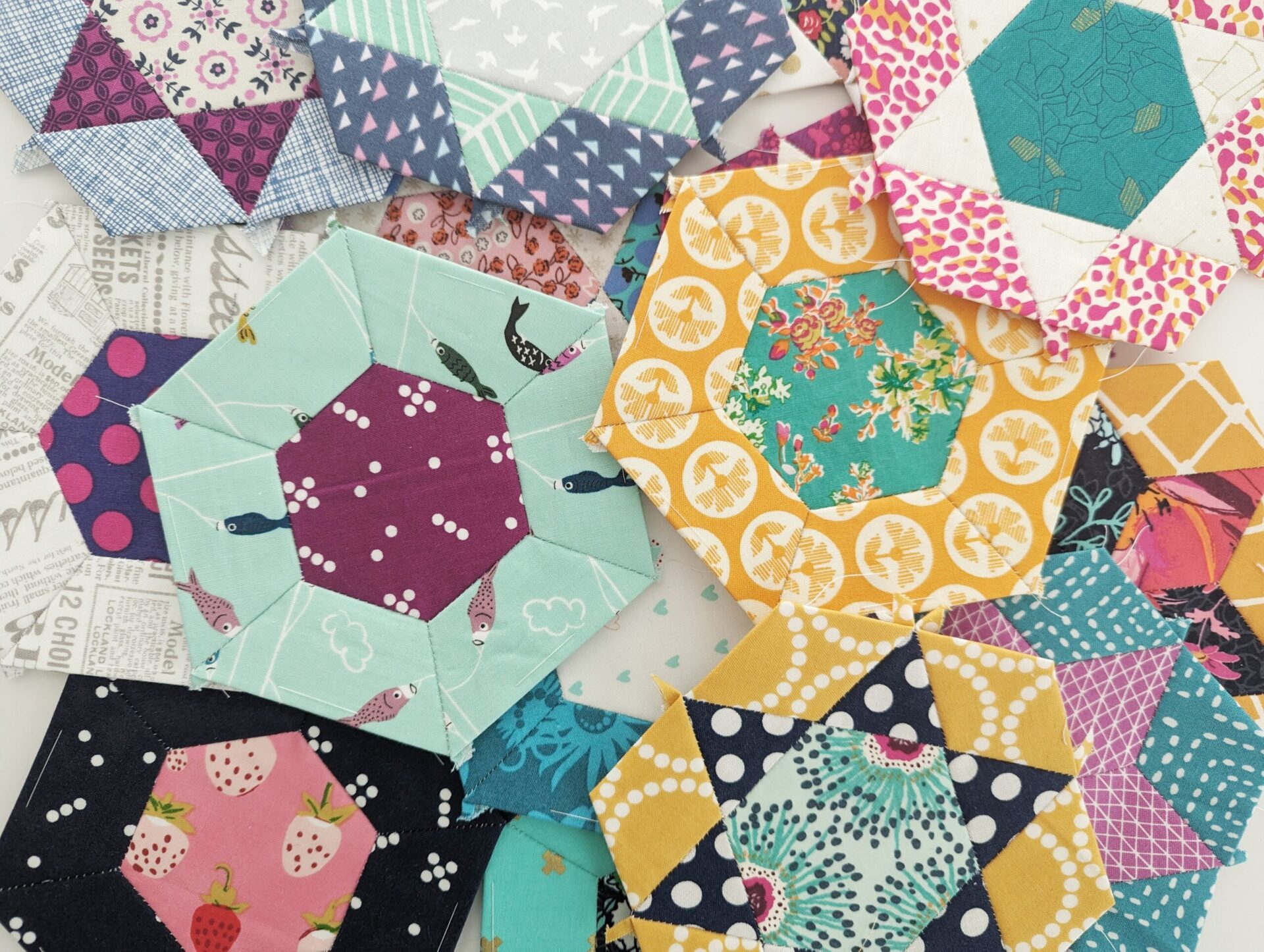
English Paper Piecing (EPP) is one such method that stands out for its precision and timeless charm. Let’s go over the basics of EPP quilting by exploring the techniques, tools, and tips that make this craft both enjoyable and rewarding.
What is EPP?

English Paper Piecing is a hand-sewing technique that involves basting fabric around paper templates to create intricate quilt blocks. This method allows for precise and detailed designs, making it a favorite among quilters who appreciate the art of slow stitching.
Tools and Materials:

- Paper Templates: These are the foundation of EPP quilting. Various shapes and sizes can be used depending on the desired design.
- Fabric: Choose high-quality quilting cotton in a variety of colors and prints.
- Needles and Thread: Fine needles and strong thread are essential for neat and durable stitches.
- Scissors: Sharp, small scissors for cutting fabric and thread.
Step-by-Step Guide to EPP:

1. Template Preparation:
- Select the desired template shapes for your quilt blocks.
- Trace and cut the templates from cardstock or specialized EPP papers.
- Papers can also be purchased; be sure to read the pattern requirements, or buy a kit!
In my example, I am using a mix of different sized papers for the Smitten Quilt Pattern. For this quilt I purchased papers from Paper Pieces, and it also coordinates with the Marti Michell Perfect Patchwork acrylic templates. Some pattern makers sell the papers and templates too, like Tales of Cloth. I’m participating in their Ice Cream Soda EPP quilt-along. If you’re not one for cutting many little pieces, I highly recommend searching for patterns that come with papers.

2. Fabric Cutting:
- Cut fabric pieces with a ¼ inch seam allowance around each template. Acrylic templates can be purchased for unique shapes for patterns, and these typically have the seam allowance within the template.
- This ¼ inch will be used for basting.

3. Basting:
- Center the template on top of the fabric piece, stabilize with a pin, and baste it in place using small, even stitches. For smaller pieces, I baste by only placing stitches in the fabric (and not through the paper), but for larger pieces, I will go through the paper when necessary.
- Repeat until there are stitches around all sides of the template.
- Alternatively, you can glue baste your pieces by using a glue stick to secure the ¼” allowance around your template.

4. Joining Pieces:
- Align basted fabric pieces and whipstitch them together.
- Working from the center outwards, continue until the entire block is formed.
Pro-Tip: using quilter clips to hold pieces together is very helpful!
5. Removing Papers:
- Once the block is complete, carefully interior papers and any basting stitches going through the papers. Keep exterior (outer) papers until shapes are joined.

Tips for Successful EPP Quilting:
- Organization is Key: Keep your templates and fabric organized to streamline the piecing process.
- Experiment with Fabrics: EPP allows for creative fabric combinations and fussy cutting to showcase specific patterns.
- Take Your Time: EPP is a mindful and relaxing process. Enjoy the journey and savor the satisfaction of each finished block.
English Paper Piecing is a captivating quilting technique that offers a unique blend of precision and creativity. Whether you’re a seasoned quilter or a beginner, exploring the world of EPP can open up new possibilities for your quilting projects. So, gather your materials, select your favorite fabrics, and embark on a journey of creating timeless and intricate quilt blocks through the art of English Paper Piecing. Happy stitching!

I would love to try this, but I am somewhat intimidated by working with such small pieces and the hand sewing.
I think it’s worth trying at least once!
This technique is so easy. It just takes patience and a sharp needle to go through the layers of fabric, especially heavier cotton. I work on pieces while watching tv or listening to an audio book. I use my finished pieces, usually flower shape, for quilt blocks, coasters, placemats and table runners.
A milliners needle is very sharp, fine, and long enough my hands can hold it easily. Using a fine thread such as bobbin thread for machine embroidery makes it easier to thread the needle. Those two hints really made it go much faster and easier!